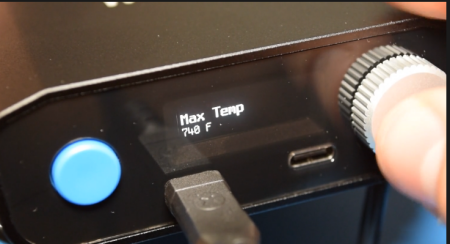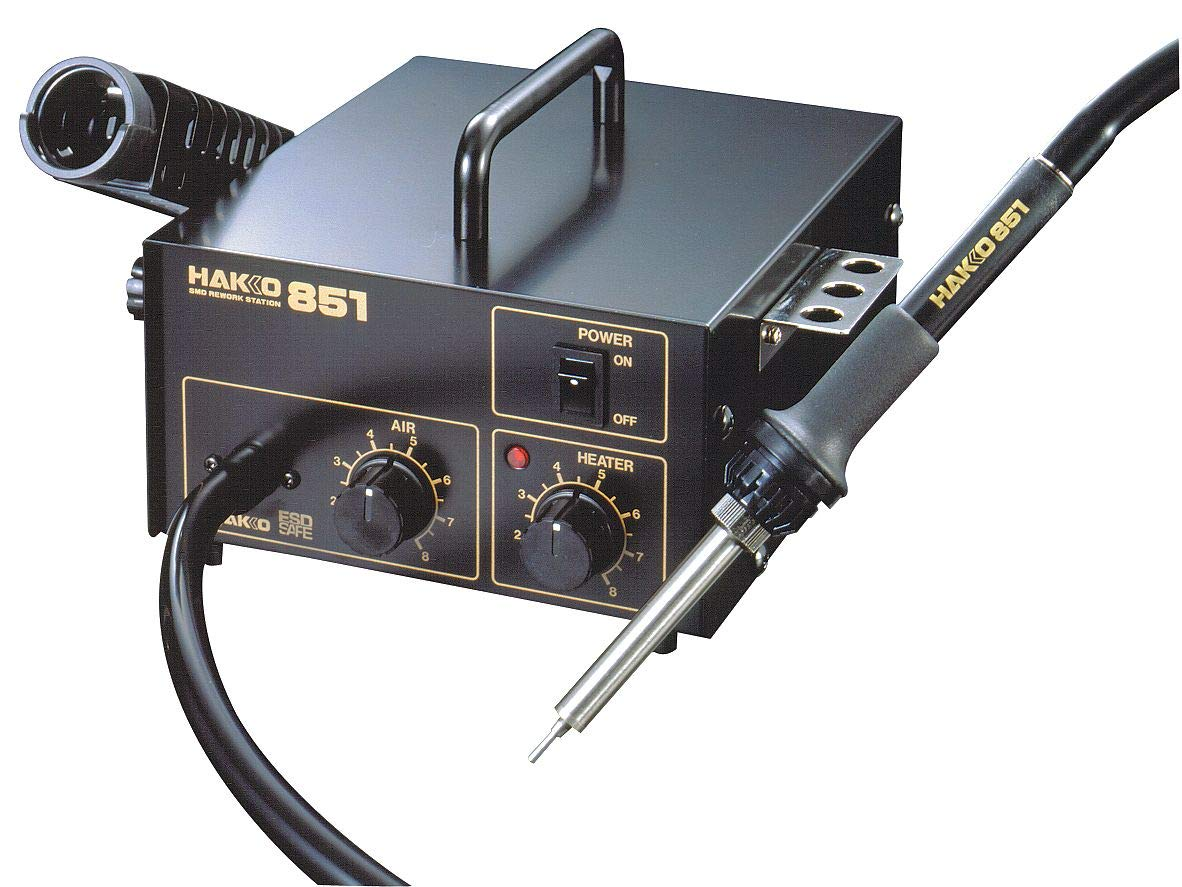Considering that they sell one of those, I’m going to assume they’ve heard of it. ;)
It’s very likely existing smart soldering pens were the inspiration.
iFixit even mentions they didn’t include a screen like the Pinecil because most people don’t actually mess with the settings that much when they are on the go.
What they probably meant is they didn’t include a screen because this way they can sell their overpriced battery pack.
It’s definitely priced significantly higher than a similar setup from Pine64.
…but it also has some significant advantages and features the Pinecil does indeed lack.
I definitely think the Pinecil is aimed more at hobbyists and this iFixit iron is aimed at people who solder all the time, in other words, not hobbyists.
Since the Pinecil is running IronOS, it’s just a matter of time for it to also get the fall detection. And apart from the LED ring gimmick, I don’t see any huge advantages over IronOS.
I personally see the PD for USB-C being 100W is a significant advantage as the Pinecil tops at 60W from USB-C and you have to search for a traditional barrel-plug power cord to get it to max out at 88W.
100W through USB-C and not even having a different power option seems pretty useful to me. *shrugs
I regularly power both my ts100 and Pinecil with a Milwaukee M18 battery and the barrel connector this is super convenient. The display is also convenient. The fact that you need the battery to set the temp seems numb and completely negates the USBC convenience because it means you can’t use any old USBC power source and still change the temperature. The 100w is also pointless because the other two options already heat incredibly fast and have a higher max temperature.
Since the Pinecil is running IronOS
What a sentence. I really don’t like the idea of having to do a firmware update on my soldering iron.
Does it have Bluetooth and a companion app as well?
You do realize that the ifixit solderimg iron also has firmware and that you need to connect it to a computer or their very expensive battery pack to adjust its settings, right?
I’m pretty sure you meant this as a joke, and I laughed at the thought of someone making something as stupid as an app for a soldering iron. But then I thought I’d check. Ugh.
https://play.google.com/store/apps/details?id=dev.eduardom.ironos_companion
having to do a firmware update on my soldering iron
You don’t. It works perfectly fine OOTB. Can’t speak for the Pinecil v2 with Bluetooth and the companion app but I have v1 and the software been stable and bug-free enough I’ve never even given a thought to updating the firmware on it
Firmware was always there in a soldering iron more sophisticated than an old, dumb Radio Shack wall plug iron. That’s how you get good temperature control. Pinecil is just letting you modify it officially.
My guess is that the motivation was user feedback and keeping things simple so they’re easier to repair.
Those look pretty cool.
But I’m confused about the marketing around the cpu/ram, etc. Does that really matter for a soldering iron? (Serious question, not being snarky).
I get they’re using that tech to make it adjustible/smart, but it’s a soldering iron, not a pocket computer.
Is there some way those specs genuinely matter? Or is it just to say “we’re using the latest tech to provide controls”?
Smart soldering irons have been around a while, so yes. It is now like a PC and specs matter a little.
One advantage smart irons have is being able to give you a readout of the exact temp of the tip of your soldering iron, something a traditional iron cannot do.
It also needs chips and sensors to do things like auto-off when it is set down.
So the quality and speed of chips affects performance.
Sounds like marketing foo.
I have a 10+ year old Weller station with digital temp adjustment, and I don’t recall it having a cpu and ram.
If it has digital temperature control then it has something resembling a CPU and memory. If it’s analog then it’s probably just not that accurate and will drift over time without manual calibration.
I have a pinecil and direct heat soldering irons blow away non direct heat irons like your weller (and I think this ifixit one). Once you switch you never want to go back. Which is really disappointing because I don’t think this new ifix it one is.
don’t recall it having a cpu
So, what’s updating the display? Power supply imps?
digital temp adjustment
Digital temp adjustment is different than a sensor that tells you the exact temp at the tip.
Pretty sure any 10+ year old unit is just setting a temp, not telling you the actual temp through a measurement.
The Weller WESD51 sets the temp at the tip and mine has done that since I bought it in 2016. A look at a datasheet dates it back to 2006 but it could be older. By definition that means it has to know what the tip temp is. As it heats up the digital display tracks the temp going up.
deleted by creator
deleted by creator
Have they not heard of the TS100 or the Pinecil?
Of course they have.
An iFixit co-founder has been responding to questions over on Hacker News:
I love my Pinecil V2. It was cheaper than my 40W entry level Weller station and heats up way faster. I run it off my Anker USB power supply and also my Anker USB power bank. The power bank only outputs 30 or 40 watts though so I might upgrade that in the future. High wattage power banks are expensive though :/
It very much sounds like ifixit are actively asking influencers/reviewers to compare it to at least one of those in the videos.
Which is a little odd to me, since I don’t think it compares favorably vs either. Maybe against the ts80p because it’s significantly lower wattage and more expensive than the other two.
The TS80P is lower wattage, technically, but the heating element is right up at the very tip, instead of having a heating element inside the handle with a long metal piece transmitting the heat. It gets hot way faster than you’d expect, it doesn’t feel like 30W at all.
It punches way, way above its weight. Unless you’re soldering pipes, comparing the wattage to traditional irons is misleading. Love that tiny thing.
Only problem is that this design necessitates proprietary tips that are relatively expensive. Not a fan of that, coming from the no name Global South Especiale 2$ firestarter irons that are the norm where I am. Not the end of the world, but worth keeping in mind.
The one I bought came with a USB-C cable that couldn’t handle the current though. That was the only real red flag. Shame too, that cable seemed like it was silicone coated and would have been ideal.
Yeah I have a ts80p but it struggles with what I usually solder so I’ve replaced it with a pinecilV2 for mobile soldering which I’ve been happier with.
That Pinecil has a 30 day warranty? Not a lot if confidence in the longevity of their product.
Here in Europe it is sold with a 2 year warranty, but it also cost nearly three times as much (65 euro vs 25,99)
My pinecil has lasted for years.
Ts80 that runs on qc3 is also very good. It keeps up with my large soldering station in real world use
Pinecil is 26$ and has a screen.
You’re probably adding $25-35 to that for a USB-C power supply that can handle it, but yes, it’s cheaper than this. $50-75 if you want it battery powered.
But yeah, I’m not sure what iFixit is bringing to the market that’s better than what exists.
The Pinecil uses a standard tip as well. So, you can get cheap ones on aliexpress. That’ll pay for it for me tbh.
It’s 80$ and doesn’t include a battery. But the ifixit one does include a USB cable and a bevel tip (cone tips are bad)
So it’s more like $26 plus $4 for pine USB cable, plus $6-11 for a ts100 bevel tip. $41 vs $80
I use a pinecil and it’s great. Tips are cheap and a standard size, it takes usb-c power and has a good user interface.
Not really sure what ifixit is trying to accomplish with this overpriced iron.
Pine have so many neat things.
Tying a rechargeable battery to a single function device seems off-brand for iFixit.
- edit, I am wrong. I didn’t RTFM. Humble pie is good sometimes.
It’s a multi-use battery.
The battery can be used to charge whatever you want. A phone, laptop, headphones, or anything else with USB. Also, the battery is user replaceable and the product repair diagrams are posted online.
IMHO, it looks like they’re practicing what they preach, and it’s all designed for longevity and right to repair.
I edited my original post. Thanks for bringing the pie!
For 250 dollars. iFixit is turning to the Apple of repair.
That is pricey… However, as someone who has an ifixit toolkit that contains just about every shape and size of screwdriver bit ever imaginable (and several that defy explanation), it has been the most useful tool I have ever purchased. I can’t even count how many times I’ve used it.
And the quality is outstanding.
I’ll gladly pay a premium for something that will be “buy it for life” or at least last decades. Phones and computers have inherent obsolescence, but most tools don’t. I don’t buy chinesium tools, I buy reputed European, American, or Japanese tools, the lifetime stuff.
same. no more knuckle busters for me. I’ve got spanners that are 20 years old that I bought, not inherited.
Soldering stations that are fixed to an outlet are also expensive. It’s not a cheap tool kit. If it is cheap, it’s a garbage iron that will likely do the job but you will struggle.
I’m trying to buy one for work and every station worth considering is easily over 200 dollars US.
The pinecil is an excellent iron that is not expensive in the slightest
That thing is pretty awesome! I’ve never heard of it. Thanks for the suggestion.
Does it matter if the products last longer than an apple product and can likely be repaired?
Of course it does, I was talking more about price than repairability.
Just curious what do you think a reasonable price would be for this product?
A pinecil is 25$ and a 40kmah battery pack is 35$, so the combination… 60-70 bucks.
I’ve never used one but I just looked up the specs and it looks like it maxs out at 75 watts. Is that enough to keep it hot with like 16 gauge wires?
The pinecil will go up to 126w if you have a capable power supply. I am going to be honest though, 16awg isn’t that large. A 45w iron could probably handle that fine if you are ok with waiting a but for your wires to get up to temp.
I have a 60w iron and 16awg is always the size that’s just too big for me and always a pain to solder.
deleted by creator
I’d say an absolute maximum of 100 USD
A traditional soldering iron in my nation costs about PHP 450 (about USD 7.95). The portability, accelerometer, temp control, easy repair and the ability to solder while charging a phone are 👍, but USD 250 is so high.
What I want from a battery soldering iron is a field-replaceable 18650 in the handle, not Webserial.
Build a 18650 battery bank and plug in a pinecil or ts100. A solder iron with a 18650 would be heavy and uncomfortable for soldering.
I would accept a bit of an awkward balance for being self-contained.
You’d want more than one cell. You’d be pulling 23amps from a 4.2v 18650 to give the same 100w at 20v power as you get from a top usbpd power supply.
There are 18650s that do 30 amps for short bursts, but it would get as hot as the iron and be empty in 5 min
I would not want multiple cells for reasons of ergonomics and convenience.
I probably don’t need 100W for most field soldering. 60 is plenty, and temperature-controlled soldering irons usually don’t need to pull high current continuously. It would need 60W for maybe 10 seconds when powered on, and when heating something large. The rest of the time, it takes relatively little power to keep the tip hot.
What I’m describing is, of course not the right tool for production soldering. It’s for field work.
I’ve got a Ts80p which is a qc3 usbc soldering iron for that. It’s crazy powerful for it’s size and runs off a pretty small anker powerbank. You could slide that into your sleeve to go portable and one handed
That’s similar to the iFixit iron, as is the less expensive Pinecil.
Those are probably the best options currently available, but I want something more compact and self-contained.
If you need to not have a cable, the butane ones would be a better fit.
Having used a butane iron before, I don’t think it would. They don’t have the temperature control modern digital irons can, and they’re forbidden on flights.
I haven’t done the math, how much runtime could you get out of a single 18650? They’re pretty stout, but it seems like they’d be a bit underpowered.
Milwaukee 12v batteries are 3 cells (I think they’re a little smaller than 18650), and you can run through a battery pretty quick (I believe they’re 1.5AH). Though I don’t know how efficient their heating design is.
Assuming the M12 CP1.5 battery pack, it’s probably three 18650s. Specifically, it’s probably three LG HB series 18650s, which handle high burst loads well, but hold only 1500 mAh. A single Sony VTC6 holds 2/3 the energy of one of those packs. Wait… why am I speculating? Youtubers tear down power tool battery packs on video all the time, and someone did that one. They’re Samsung 15Ms, which are a little worse than HBs.
Anyway, short runtimes are fine for most field repairs, which is the whole point of something entirely self-contained. Spare batteries can extend it indefinitely, but a battery soldering iron is probably not what I’d pick for extended soldering sessions.
Lol, I get it, I often start doing the math and realize “someone has already done this”.
Cool, thanks for the link. I already knew the little 12v batteries suck (though they work fine for the intended purpose, like impact driver or work light). I kill them with any other tool.
Yea, I was just thinking is the runtime reasonable enough that having spare batteries is a sufficient approach. Like you said, long runtime isn’t required, 15 minutes total runtime is probably more than enough (though that would be hell on battery life cycle).
Since I already have a slew of Milwaukee batteries, I’m trying to avoid things with 18650, except where form factor matters (like my flashlights). A Single Battery to Rule Them All (or at least most things).
The Smart Soldering Iron will set you back $80, while the Soldering Station, which includes the soldering iron and the battery pack, costs $250.
Most interesting to me is that they put the display on the soldering station/battery pack thingy instead of the iron itself.

I bought my soldering station with air solderer and iron solderer for about 40$ from AliExpress, the ones with IR bottom heater cost around 90-100$
What’s the IR bottom heater for?
IR bottom heaters are usually not strong enough for reballing. They’re for boards that are hard to solder, because there’s a lot of copper or a heatsink for example.
The bottom heater preheats the whole board, not to soldering temperatures but enough to make soldering a lot easier.
Reball of chips on gpus and motherboards of PCs and gaming consoles
Ah. Other than fixing the old Xbox360 RROD , I’ve never needed to do any BGA work, just circuit soldering
Those Nvidia cards used in mining and AI need reballs regularly, also ps4 south bridge often falls off, also intel sockets sometimes need reball, also you can upgrade ram on your phone and Nintendo switch
Oh for sure. I’m not knocking those that can do it, just that my regular soldering skills are shit enough that I’d probably be hesitant to reball something more complicated even with the right gear :-)
Temperature is measured in Farads.
Very non-standard
So basically a copy of the battery pack T12 devices from China. Well done. You fixed an already fixed problem.
I love my ifixit precision screwdriver, so I’d be a fan and would try this out.
The thing is once I switched to a butane iron (portable, hot in 20 seconds, awesome fire) I don’t have any interest in anything with a wire coming off of the back of it. battery or no, the wire being in the way is ass and is also crap
edit: maybe it doesnt have a wire?
edit 2: maybe I shoulda read the article before typing? 5 second heat-up time, wow… seeing as I am a fucking idiot and am also very tired, can someone who is smart tell me if the iron has a battery itself? the pack is for recharging the small battery in the pen?
It does not have an internal battery but can use any battery pack that can do 100W output.
I pre-ordered this for a few reasons. One, my experience with butane irons was very different than yours I guess. I hated how long they took and how finicky they were. Then I had to find a safe place to put it while it cooled. This has a cap that can handle the high temp with no issue.
When I need a portable iron it’s to do small quick soldering with long waits in between. This seems perfect for that.
This Antex is about 30 years old, has a heat resistant cap and is still going strong :) Don’t know what they’re like these days but I’d recommend on my experience.

fair enough, thanks for the response.
my ‘extra hands’ station w/ the two alligator clips to hold the subject, magnifying glass w/ led also has a holster for a hot iron, so I pop the hot iron in that after soldering.
the wire coming from the iron, whether it goes to a battery pack or the 250 eur smart battery is still the hangup for me. I build large things with nicrocobntrollers in them, so I need to soldier in super awkward places. a wire connecting the iron to anything is a massive liability.
Id be interested to hear how you get on with it though
Electronics usually wants to control the temperature range more tightly than a butane soldering iron could do. Fine for plumbing work, though. Electronics soldering irons usually don’t have the thermal mass to handle plumbing work.
My biggest complaint about the ts100, Pinecil, and the iFixit station is that the tips are specialized and rather expensive.
Pinecil tips are standardized and third party options are extremely cheap on aliexpress or amazon
Having used an expensive Metcal, I would like someone to develop that level of performance for less. I want the precise thermostat and high quality tips, but I don’t solder enough to justify the expense. I am happy to see iFixit driving innovation in this market though. Weller needs some real competition.
Love my Hakko. Paid a little over $100 for it several years ago. It costs 10x as much as the cheapest option but is 100x better.
How precise are you talking? Usually, cheaper soldering stations get that way by not having a lot of thermal mass, which is particularly needed for desoldering. Otherwise, the PID control tends to keep things good enough. Tuning the PID parameters can make a difference, but once you have a heater and a heat sensor, the software is more or less the same for everyone.
Ah any reason why Firefox decided not to include WebSerial?
Maybe you don’t want to buy the Station, or you left it at home. In either event, you can simply plug the iron into your computer and configure it via WebSerial.
You’ll need a browser based on Chrome to pull this trick off, as Mozilla has decided (at least, for now) to not include the capability in Firefox. In testing, it worked perfectly on both my Linux desktop and Chromebook.
Unfortunately, plugging the iron into your phone won’t work, as the mobile version of Chrome does not currently support WebSerial. But given the vertical layout of the interface and the big touch-friendly buttons, I can only assume that iFixit is either banking on this changing soon or has a workaround in mind. Being able to plug the iron into your phone for a quick settings tweak would be incredibly handy, so hopefully it will happen one way or another.
The WebSerial interface not only gives you access to all the same settings as plugging the iron into the Power Station does, but it also serves as the mechanism for updating the firmware on the iron.
I believe this is one of those Google “F it I am going to make this protocol my own way without anyone else’s input” which results in security concerns and also Mozilla prioritizes it being a browser more.
Searching serial looks like this is still the case. There are security and privacy concerns over it.
For those not wanting go search:
Mozilla’s Position
Devices that offer serial interfaces often expose powerful, low-level functions over the interface with little or no authentication. Exposing that sort of capability to the web without adequate safeguards presents a significant threat to those devices. A user deliberately installing a site-specific add-on may be adequate, given sufficiently understandable consent copy.
Seems reasonable to me.
Google mainly built this WebSerial shit because they HAVE TO to make Chrome OS more than just a useless web browser.
Good news, I guess?
https://github.com/kuba2k2/firefox-webserial
I’ve only used it to do some esp32 stuff with homeassistant, but it does work.
I’ve also used this for the esp32 and firefox and it worked just fine in that case
Removed by mod
I’ll give it a shot. Seems interesting to have something USB powered that can solder.
I’ve been using a Pinecil which is USB-C powered. It heats up in seconds and the temp can be adjusted easily. The big plus to me is how small it is. It’s so much easier to handle than a standard iron, and the tips are push-in and can be locked with a screw so they’re easy to swap.
Let us know how it works. It sounds pretty cool, but ive been disappointed with battery powered soldering irons.
pinecil can be battery powered too and I’ve had a good time with mine. granted the battery is either a laptop power bank or a drill battery, but it’s still portable enough for me
I always thought the “fix” to a traditional soldiering iron was a hot air pencil.
Do those exist?
Yep, for decades. They used to be much larger consuming the space of a large table. Now they are small units like this:

Just search for “surface mount rework” or the nickname “hot air pencil”.
I wonder if you can run it off any USB C PD that will do 100w+ without buying the battery pack. I know my MBP USB C power supply does at least 100, if not more on MagSafe.
The article seems to say it can, though they’re promoting their own, of course
USB C PD is a standard so yes, as long as the device you purchase to power it supports 100w PD via USB C then will work.
Cool, thanks!
Spam.
I just blocked OP, “Ghostal Media”, but I liken it more as essentially an adblock
Look at their post history. They arent a spammer by trade. The article posted does read like a paid review, though. And the other posters here have done similar while offering counterpoints.




















